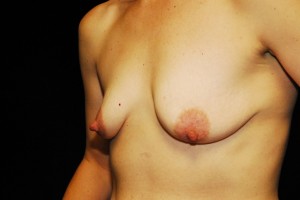Breast Augmentation in Dallas, Plano, Garland, Mckinney and Rockwall: silicone versus saline implants
SALINE OR SILICONE,WHAT IS THE BEST IMPLANT CHOICE FOR ME?

As a plastic surgeon who sees patients from Dallas, Plano, Richardson, Rockwall, Garland, Mckinney and Allen, one of the most common discussions with patients interested in breast augmentation and breast implants concerns the relative merits of saline versus silicone implants.

The photo above is a patient of mine who underwent an augmentation and a breast lift at the same time.
The good news is that both saline implants and silicone implants are excellent devices and patients are choosing between two great options!
To understand the advantages of the different implants, it is helpful to understand the most common problems with breast augmentation, and what issues we are trying to avoid or minimize. The most common problem with breast augmentation is that sometimes the body forms hard scar tissue around the implants, resulting in an abnormally firm breast that may ride high or have some distortion. This hardness is called “capsular contracture” and is the most common reason for redo or revision surgery. Other complications include breast implant leaks, asymmetric or unsatisfactory positioning of the implants requiring revision.
In order, I would like to detail the advantages and disadvantages of both silicone and saline implants.
The pros of silicone implants:
1) silicone implants have a more natural feel than saline implants: reproducing more accurately the softness of a natural breast
2)silicone implants will have less tendency to show implant edges at the lower and outer edges of the breast and hence may be a better choice for thin patients without much soft tissue to hide or cover a breast implant.
3)silicone implants have lower leakage rates than saline implants, even when carefully followed by MRI scanning. Leakage of a saline implant is most often a complete loss of volume, often creating asymmetry that can be socially troubling.
4)silicone implants are pre-filled and hence do not require intra-operative filling: probably translating into slightly shorter time under anesthesia.
5)the short term follow-up of the new silicone implants show overall complications and specifically capsular contracture rates comparable to saline.
The pros of saline implants are as follows:
1)the long term complication rate of saline implants is well known and is relatively low (most commonly estimated at a 1% risk per year…so after 30 years of having implants, the risk of hardening is roughly 30%). The long-term capsular contracture rate of silicone implants is unknown; the old silicone implants had high rates of leakage and hardening after 10 years (over 60% rate of leakage alone). We hope the new silicone implants will have a better track record, but we honestly don’t know yet.
2)saline implants cost, on average, $1000 less than silicone implants
3)saline implants can be placed through a smaller incision. Some incisions are therefore possible with saline that are not possible with silicone; for example it is difficult to place a moderately large silicone implant through an axillary incision or through a peri-areolar incision in a woman with a small areolar diameter).
4)saline implants are available for women under 22 years of age (the FDA has limited the use of silicone implants to woman 22 and older).
5)the follow up care for saline implants is simple and cost effective. However the recommended follow-up care for silicone implants is more costly and complicated. Allergan recommends an MRI scan three years after implant placement and then every two years thereafter. Insurance largely does not cover this cost (an MRI scan of both breasts commonly is over $15oo per study). Many woman choose to stick with routine mammograms and sonograms for their follow-up care (about 80% of the sensitivity of an MRI scan). Mammograms and sonos are normally covered b insurance. The breast implant warranties are still valid even if MRI scans are not obtained, but the fact that the implant companies recommend the MRI scans is a concern for some patients.
6) Saline implants have a variable fill volume for each size implant, hence small breast asymmetries can be corrected without having to change the diameter or size of the breast implant
7)although saline implants leak more; if they do leak, there are no concerns for causing tissue problems. Silicone gel however, over a long period of time, can cause tissue inflammation, granulomas, implant calcification and can rarely migrate to regional lymph nodes.
The superior aesthetics of the silicone implants together with the excellent results in the recent studies (admittedly with relatively short term, 4 year follow-up) has led to higher utilization of silicone implants than saline both in our practice and nationally. Currently in my own practice, aproximately 80% of recent patients have been choosing silicone implants.
However, it is very important to realize that every patient has highly specific goals and desires: every potential breast augmentation patient must weigh their options with their own needs in mind.
If you would like to have an individual consultation, we would be glad to meet and discuss these issues with you in person. Call 972 470-5000 ext 203. Our cosmetic coordinator Stacey will be happy to give you additional information and schedule an appointment.
Denton Watumull MD FACS
 Call
Call Email
Email


